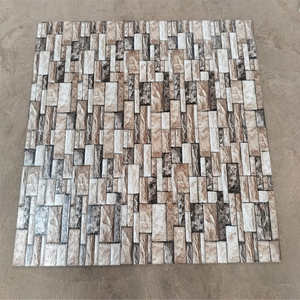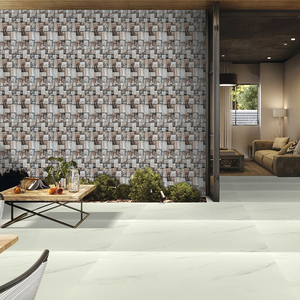
All categories
Featured selections
Trade Assurance
Buyer Central
Help Center
Get the app
Become a supplier

(10748 products available)








































Interlocking stone designs are also called interlocking pavers, which are concrete slabs specifically designed to be placed adjacent to one another. These stones have different designs that enhance an area’s overall beauty and natural appeal. Below are the different types of interlocking stone designs.
Cobblestone Pavers
Cobblestone pavers are interlocking stones that come in different shapes, such as round, oval, and flat. These stones are mostly seen on historical paths and roads. They are designed to withstand different weather conditions and can be an excellent addition to any outdoor area.
Brick Pavers
Brick pavers are interlocking stones designed for outdoor areas like patios, driveways, and walkways. They are made from clay that is molded into different shapes and baked in a kiln. Brick pavers come in various sizes and shapes, such as rectangular and square. They are loved for their durability, low maintenance, and timeless look.
Concrete Pavers
Interlocking concrete stones are made from a mixture of concrete, sand, and other materials. They are shaped into molds and then cured in a hot environment. These pavers are popular for their versatility since they come in many colors, sizes, shapes, and textures. They also have a long lifespan and need little maintenance.
Flagstone Pavers
Flagstone pavers are interlocking stones made from natural stone materials such as limestone, slate, and sandstone. They are flat and come in irregular shapes and sizes. These stones are mostly used for patios, walkways, and driveways.
Rubber Pavers
This type of interlocking stone is made from recycled rubber materials. They are flexible and come in different colors and shapes. Rubber pavers are often used for playgrounds, pool decks, and pathways since they are slip-resistant and soft. Also, they can be easily installed and are eco-friendly.
Travertine Pavers
Travertine pavers are natural stones that are extracted from quarries. They are formed based on their porous nature. These pavers are popular because of their long-lasting nature and beauty.
Interlocking stone designs have different features and functions. Here are some of them:
Durability
The durability of interlocking stone designs makes them popular for homeowners and urban planners. These stones are tough and long-lasting, ensuring any surface remains beautiful and functional for many years. Because they can withstand harsh weather conditions and heavy traffic without deteriorating or losing their color, interlocking stones are excellent for driveways and parking lots.
Aesthetic appeal
Besides their functionality, interlocking stone designs are visually pleasing. They come in different colors, sizes, and shapes, allowing customization to suit unique preferences and architectural styles. This versatility ensures that interlocking stones enhance the beauty of any outdoor space, from pathways to patios and driveways.
Low maintenance
Another important feature of interlocking stone designs is their low maintenance. Once installed, these stones require little care to stay in good condition. They can be cleaned easily, and weeds can be removed, ensuring the interlocking stones remain beautiful and functional for many years.
Eco-friendly
Interlocking stone designs are also eco-friendly. They are manufactured from natural materials that can be recycled. Most interlocking stones have holes that allow water to permeate the ground, reducing surface runoff and preventing flooding.
Versatility
Interlocking stones come in different colors, sizes, and textures, making them suitable for different applications. For example, cobblestones can be used to create driveways, paths, and patios. Their versatility ensures they can be adapted to any design or functional requirement.
Stability
Interlocking stone designs are stable. Their design allows them to fit together tightly, creating a stable and strong surface that can withstand pressure without cracking or shifting. This stability makes interlocking stones popular for high-traffic areas like commercial plazas and public spaces.
Interlocking stone designs have diverse applications across various industries and sectors. Here are some common scenarios where interlocking stone designs are widely used:
Landscaping Projects
Interlocking stones are commonly used in landscaping projects, including: Driveways: Interlocking stones create durable, attractive driveways that can withstand heavy vehicle traffic. Patios: Interlocking stones design custom, resilient patios that enhance outdoor spaces and create distinct visual effects. Walkways: Interlocking stones are used to make interlocking walkway stones that are easy to install and maintain while providing a beautiful look to the landscape.
Building and Construction
Interlocking stone designs are widely used in construction and building, including: Foundations: Construction workers use interlocking stone designs to build stable and robust foundations for different structures. Walls: Interlocking stones create resilient walls for buildings, retaining walls, and landscape borders. Structures: Interlocking stone designs are used to build different structures, including commercial and residential structures.
Urban Infrastructure
Interlocking stones are widely used in urban infrastructure projects, including: Streets: Urban planners use interlocking stones to construct durable and attractive streets that can withstand constant traffic. Public squares: Interlocking stones design attractive public squares that enhance urban spaces and provide areas for public gatherings and events. Parking lots: Interlocking stones create strong, resilient, and low-maintenance parking lots for public and private spaces.
Commercial and Public Spaces
Many commercial and public spaces feature interlocking stone designs, including: Malls and shopping centers: Interlocking stones create attractive, resilient shopping areas that can withstand high foot traffic. Parks and recreational areas: Interlocking stones are used to design paths, patios, and walls in parks and recreational areas. Hotels and resorts: Interlocking stones enhance the outdoor spaces of hotels and resorts, including driveways, walkways, and patios.
Residential Areas
Many residential areas feature interlocking stone designs, including: Homes: Interlocking stones enhance outdoor spaces in homes, including driveways, patios, and walkways. Residential complexes: Interlocking stone designs create attractive outdoor areas for residential complexes. Gated communities: Interlocking stones enhance the outdoor spaces of gated communities, including streets, driveways, and public spaces.
Choosing the right interlocking stone for a specific project requires careful consideration. Here are some factors that a customer should consider when selecting interlocking stone designs.
Function
It is important to determine the intended use of the space where the interlocking stone will be installed. If the stones are intended for use on a driveway, it is important to choose stones that are durable and resistant to cracking. For walkways and patios, the interlocking stones should be chosen based on their texture and color.
Materials
Interlocking stones are made of different materials. Each material has different characteristics that make them suitable for different applications. It is important to consider the materials used to make the interlocking stones. Concrete interlocking stones are affordable, come in different colors and patterns, and are durable. Brick interlocking stones are made from clay, and they offer different shapes and sizes. They are durable and ideal for driveways, walkways, and patios. Flagstone interlocking stones are made from slate, limestone, and sandstone. They are long-lasting and ideal for patios and walkways.
Design and style
The design and style of the interlocking stones are important factors to consider when selecting interlocking stone designs. Interlocking stone designs differ in texture, color, shape, and size. It is important to choose interlocking stones that will complement the existing landscape to enhance its visual appeal.
Color
Interlocking stones come in different colors. The color of the interlocking stones plays a very important role in enhancing the visual appeal of a space. It is important to choose interlocking stone colors that will complement the architectural design of a space.
Size and shape
Interlocking stones are available in different sizes and shapes. It is important to consider the size and shape of the stones to ensure they fit the space where they will be installed. It is also important to consider the thickness of the interlocking stones to ensure they are suitable for the intended use.
Q1: What are interlocking stone designs for patios?
A1: Interlocking stone designs for patios involve patterns where each stone fits securely with the ones around it. This can be shapes like herringbone, basketweave or running bond. Designs where each stone has the same shape as all the others, like square or octagonal, also interlock well.
Q2: What are the design stones for driveways?
A2: Patterns that can be used on driveways include herringbone, running bond and basketweave. Single shapes like square or octagonal are also good for interlocking. The patterns should be tight so the stones stay in place and don't move around when cars drive over them.
Q3: How does one design interlocking stones for walks?
A3: Stones for walks can be fitted into patterns like herringbone or running bond. Individual shapes like octagonal or square are also good for walking paths to make sure the stones stay in place and don't shift when walked on.
Q4: What are the benefits of interlocking stone designs?
A4: Interlocking stone designs are beneficial because the patterns distribute weight evenly so the stones don't move or shift over time. They also allow for water to seep into the ground instead of puddling on top, which is better for the environment.
Q5: Do interlocking stone designs have any disadvantages?
A5: One downside is that installing the patterns can take more time and work compared to loose styles. It also requires planning and knowledge of how the shapes and patterns fit together securely. If done incorrectly, the stones could shift later on.